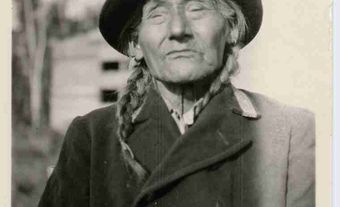In 1886 Prime Minister John A. Macdonald had the idea of bringing the "loyal chiefs" - those who had refused to join the Northwest Rebellion - east. The tour moved by train through Regina, Winnipeg and then on to Ottawa and finally to Brantford, Ont, for the unveiling of a statue of the great Mohawk leader Joseph Brant.
Much of the attention of the gathered crowds and of the media was focused on Crowfoot - the white man's ideal of a noble Plains Indian - but ironically Crowfoot had agonized over his decision to keep the Blackfoot out of the conflict. For Red Crow, chief of the Kainai (Blood), there had never been any ambivalence. The proud chief did not consider his people inferior to white people and would not join a war against them. This pride would be of great value to his people in the difficult days ahead.
Red Crow was born in 1830 near the confluence of the Oldman and St Mary's rivers, in the heart of the Kainai hunting grounds. He earned his grown-up name Mi’k ai’stoowa, or Red Crow, when he first went to war as a teenager. The 1840s and 1850s were a period of constant raiding by all the Blackfoot - young men risking their lives for glory and gain - against the Crow, Cree, Shoshoni, Gros Ventres and Nez Percé. By the late 1860s Red Crow was a respected warrior, always first to defend the camp or to extract revenge. When in 1869-70 smallpox carried off many of the chiefs, it was not automatically assumed that Red Crow would become chief. The people chose him in their traditional way, following him when he broke camp.

|
| Red Crow's wise leadership helped the Blood through the devastation of losing their land and way of life (Provincial Archives of Alberta). |
As chief Red Crow was always ready to defend Blood territory. In October 1871 he led 60 warriors in a strike on a Crow camp on the Upper Milk River, killing at least 60. In camp, however, life became more and more demoralizing as the Kainai were devastated by smallpox and the pestilence of alcohol, which affected Red Crow as much as others, as he killed his own brother Kit Fox in a drunken brawl. Somewhere in that time Red Crow changed. "I have had enough of war and trouble," he said.
In 1874 the North-West Mounted Police arrived on the Belly River and put an end to the American whiskey trade. Largely on the basis of his friendship with the legendary James Macleod, Red Crow led the Kainai in the signing of Treaty Number 7 at Blackfoot Crossing in September 1877. For the Canadians the treaty meant the surrender of the vast hunting grounds of the Blackfoot to settlement. But like other chiefs Red Crow attached no great significance to the treaty. The Kainai had no concept of a "reserve." They had wandered for millennia in pursuit of the bison, all the way to the Rocky Mountains, "the backbone of the world." The land and animals did not belong to the people. They were created by Napi when the world began and could not be "surrendered" to anyone.
Doubts about the treaty crept in soon after it was signed. Nothing was done, as promised, to stop the indiscriminate slaughter of the bison by American hunters. As the bison herds disappeared Red Crow began to see the value of the treaty for the future. He was proud, even haughty, but he accepted reality. The bison were gone. While other chiefs clung desperately to the old ways, Red Crow looked ahead. He was able to persuade the commissioner to move the reserve south to the Belly River, a haven from the encroaching world where he could encourage his people to take up farming and raising cattle.
The prairie world broke into turmoil in March 1885 when the Métis, Cree and Assiniboine took up arms. Red Crow's decision to keep the Blood out of the rebellion was never in doubt. He had no hatred for the white man. The Cree, however, were a different matter - they were inveterate enemies.
Red Crow had many political battles remaining with Canadian bureaucrats, however, over rations, boundaries, encroachments and broken promises. In the 1890s a high-minded and autocratic agent by the name James Wilson campaigned to eradicate the Sun Dance and medicine pipe dances. Red Crow used diplomacy and patience and after ten years of persecution was able to reinstate the Sun Dance. It was a fitting end to his career, saving the very basis of his people's religion from destruction.
Red Crow crossed the Belly River for the last time on August 28, 1900. When he did not return, his wife Sitting Before went looking for him and found him lying in the gravel at the edge of the river. He had won most of the battles of his life, despite the tragedy of his people. During his life, the Kinai had been lords of the plains and then lost everything. Under his wise leadership they did not lose their sense of well-being. He made them believe that they were the "cream of creation."

 Share on Facebook
Share on Facebook Share on X
Share on X Share by Email
Share by Email Share on Google Classroom
Share on Google Classroom
